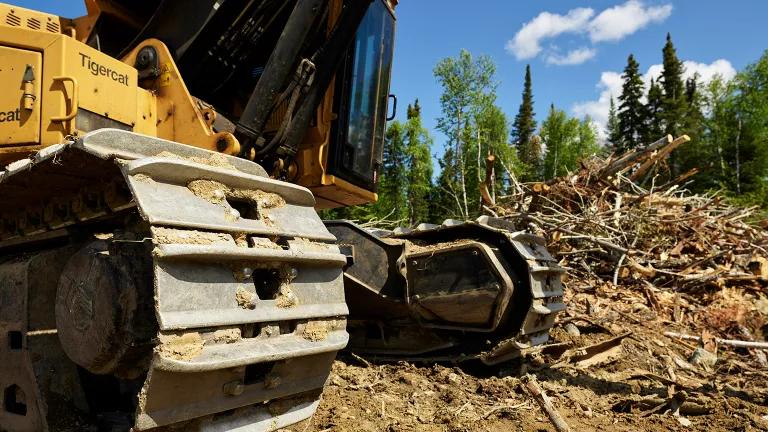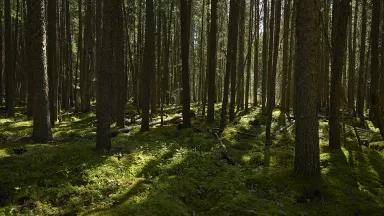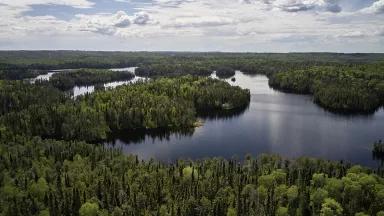The Best and Worst Toilet Paper, Paper Towel, and Facial Tissue Brands
Tissue paper production is taking a devastating toll on forests. NRDC’s newest Issue with Tissue report can help you find earth-friendly brands.
Few people give much thought to how their toilet paper or other tissue products are made. So most of us probably don’t realize that the average American uses more than 50 pounds of tissue paper annually—or that to make these paper products, companies are purchasing fiber that comes from trees logged in climate-critical forests. Our latest Issue With Tissue report and sustainability scorecard illuminate the serious environmental impacts that some of the most popular U.S. tissue brands are having on forests, as well as the steps consumers can take to make the most sustainable choices. Here’s where to start.
Understand why tissue paper production is harmful to our forests and planet
U.S. consumers need only look north to see the effects of paper production on our environment. The world’s largest intact forest, the Canadian boreal, is being cut down at an alarming rate, in part to feed consumer demand for paper products. Between 1996 and 2015, loggers clearcut 28 million acres of woodland, an area roughly the size of Ohio. And the United States is the largest driver of this forest loss. In 2022, it accounted for 65 percent of all of Canada’s pulp and paper exports, which are then used by some of the biggest household brands for everything from paper towels to toilet paper.
The Canadian boreal’s trees, soils, and peatlands store massive amounts of carbon—gases that get released into the atmosphere when trees are cut down. (By conservative estimates, logging in the boreal emits 26 million metric tons of carbon every year, equivalent to the annual emissions of 5.5 million passenger vehicles.) In addition to robbing the planet of one of its most important defenses against climate change, the logging also destroys and degrades wildlife habitat and threatens the lands and ways of life of Indigenous Peoples.
Buy the best toilet paper, paper towel, and facial tissue brands
Luckily, there are plenty of competitively priced varieties of tissue paper with minimal impact on forests. We’ve assigned grades to all the major U.S. brands of toilet paper, paper towels, and facial tissues. This includes house brands at leading supermarkets and brands that promote more sustainable practices, many of which were launched in only the past five years. Here’s what the highest scores mean for shoppers:
- A+ Grade: These tissue paper products are made entirely of recycled material, use a chlorine-free bleaching process, and have the highest percentage of postconsumer recycled paper, which diverts waste from the landfill and promotes a more circular economy. (The alternative—pre-consumer recycled content—is largely scrap and excess raw material collected during the manufacturing process. While a step in the right direction, it does less to offset waste.) Some of the highest scoring toilet paper brands, for example, are 365 by Whole Foods Market 100% Recycled, Green Forest, Natural Value, and Trader Joe’s.
- A Grade: Grades of A go to paper brands that also contain 100 percent recycled content but a lower percentage of postconsumer recycled paper. Toilet paper examples include: Seventh Generation Extra Soft & Strong, Who Gives a Crap 100% Recycled, and Everspring 100% Recycled.
- B or B+ Grade: Dozens of brands received a B or B+, most of which are part of the rapidly emerging market of bamboo-based paper brands. While bamboo is less environmentally friendly than recycled material and can be problematic if a bamboo plantation was established by clearing a natural forest, bamboo is a fast-growing plant with a much smaller land-use and carbon footprint than Northern Bleached Softwood Kraft (NBSK) fiber, the form of wood pulp commonly used in tissue. Some toilet paper brands with this grade include: Amazon Aware, Caboo, and Who Gives a Crap Premium 100% Bamboo.
Skip the worst toilet paper, paper towel, and facial tissue brands
Of course, you also want to avoid the worst culprits. Here’s what a failing tissue paper grade means.
- D and F Grades: Brands that get a D or F on our scorecard rely entirely (or almost entirely) on forest fiber for their products. And, as with all four past iterations of this scorecard, the flagship household tissue brands from the “Big Three” U.S. tissue producers—Georgia-Pacific, Kimberly-Clark, and Procter & Gamble—are made almost exclusively from forest fiber. These and other failing tissue products have three times the carbon footprint of those made from recycled paper, and many use dangerous bleaching processes. Some of the most egregious tissue paper brands are Angel Soft, Charmin, Cottonelle, Quilted Northern, and Scott 1000.
You may notice that the label “FSC certified” appears on some of these brands, a stamp of the Forest Stewardship Council. While the label does indicate the product was sourced from a more responsibly managed forest, there is no reason tissue products should be made from trees in the first place, when there are plenty of affordable and sustainable alternatives.
Reduce your household use of toilet paper, paper towel, and facial tissue
Aside from making better brand choices, you can also work to reduce your overall consumption of tissue paper products. Here are a few simple ways.
- In the kitchen: Keep rags beside your sink to use instead of paper towels.
- Around the house: Replace paper napkins with cloth versions and one-and-done facial tissues with handkerchiefs and washcloths, which you can wash and reuse.
- In the bathroom: Consider buying a bidet or bidet toilet seat attachment, which are becoming more popular. These help cut down on the use of toilet paper while requiring less water per use than the tissue-making process.
Demand accountability from corporations and lawmakers
And finally, you can help push for broader and more rigorous forest protections. Despite the steady degradation of forests like the boreal in Canada, leading tissue brands stubbornly maintain their unsustainable approach to tissue paper manufacturing and marketing. Bounty, Charmin, Kleenex and other brands continue to manufacture tissue using methods that have changed little since the 19th century, still relying almost entirely on forest fiber while perpetuating misleading claims that their products support healthy forests. Meanwhile, they have vast research and development budgets that they could leverage to create soft, strong, and sustainable tissue products.
You can help us push for change. Here’s how.
- Spread the word: Share the latest Issue with Tissue scorecard above with friends and family. You can also call out failing brands publicly.
- Use your consumer power: Ask your local store’s manager to stock more sustainable options and then shop accordingly, using our scorecard as your guide.
- Speak up: Support stronger regulations that protect forests and respect the rights of Indigenous Peoples. New laws—like the recent European Union ban on the import of products that promote deforestation and forest degradation—can help transform supply chains and, ultimately, the health of our planet’s forests.
This NRDC.org story is available for online republication by news media outlets or nonprofits under these conditions: The writer(s) must be credited with a byline; you must note prominently that the story was originally published by NRDC.org and link to the original; the story cannot be edited (beyond simple things such as grammar); you can’t resell the story in any form or grant republishing rights to other outlets; you can’t republish our material wholesale or automatically—you need to select stories individually; you can’t republish the photos or graphics on our site without specific permission; you should drop us a note to let us know when you’ve used one of our stories.
Industrial logging for forest products is destroying more than 1 million acres of the boreal yearly.
Tell P&G President & CEO Jon Moeller that enough is enough.

Tell Procter & Gamble to stop flushing our forests!
Industrial clearcutting for forest products like P&G’s Charmin toilet paper is destroying more than one million acres of the boreal forest each year. Tell P&G President & CEO Jon Moeller enough is enough.





How to Make a Wildfire Evacuation Plan
When Customers and Investors Demand Corporate Sustainability
In Planning for Climate Change, Native Americans Draw on the Past
How to Make a Wildfire Evacuation Plan
When Customers and Investors Demand Corporate Sustainability
In Planning for Climate Change, Native Americans Draw on the Past
How to Make a Wildfire Evacuation Plan
When Customers and Investors Demand Corporate Sustainability
In Planning for Climate Change, Native Americans Draw on the Past
How to Make a Wildfire Evacuation Plan
When Customers and Investors Demand Corporate Sustainability